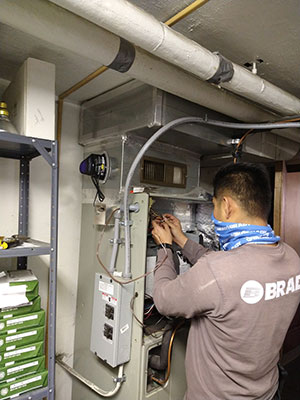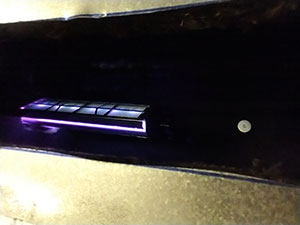Fresh-air worship indoors
 GREENSBORO — Father Joseph Mack and Father Casey Coleman have discovered an innovative way to keep SARS-CoV-2, the coronavirus that causes COVID-19, at bay in their Greensboro parishes: air purifiers that neutralize the virus in the air and on surfaces using ionic technology.
GREENSBORO — Father Joseph Mack and Father Casey Coleman have discovered an innovative way to keep SARS-CoV-2, the coronavirus that causes COVID-19, at bay in their Greensboro parishes: air purifiers that neutralize the virus in the air and on surfaces using ionic technology.
“The negative and positive ions produced also settle on surfaces as well as circulate through the air,” explained Father Mack, the pastor of St. Paul the Apostle Church.
“In both cases, the ions break down the cell walls of pathogens.”
Father Mack first learned of this technology from one of the parish’s maintenance contractors that installed the parish’s LED lighting. The contractor has a partnership with Global Plasma Solutions, which makes an air purifier that neutralizes airborne pathogens using its patented needlepoint bipolar ionization (NPBI) technology. This technology showed a 99.8 percent rate of reduction of SARS-CoV-2 in lab tests.
On Dec. 4, the parish had four NPBI purifiers installed for a total of $4,300: three on the HVAC units that heat and cool the church and another on the HVAC unit in the narthex.
Spreading the Word
Father Mack recommended the ionic technology to Father Coleman, the pastor of Our Lady of Grace Parish across town. A former mechanical engineer for Corning Cable Systems LLC, Father Coleman designed fiber-optic connectors and cable assemblies for Corning’s Hardware and Equipment Development Group before he was ordained a priest in 2015.
The science behind the ionic air-purifying system intrigued Father Coleman enough to contact the parish’s HVAC vendor, Brady Services, to inquire about installing something like it at his church. It turns out the company, owned by OLG parishioner and benefactor Don Brady, partners with RGF Environmental Group, which has developed a similar technology in its REME HALO units.
Last year as the pandemic spread, Brady installed 1,168 of these units in a variety of commercial spaces, including schools and retirement homes, and provided them to contractors for installation in people’s homes.
Both technologies – NPBI and REME HALO’s proprietary PHI- Cell – were tested against the coronavirus at Innovative Bioanalysis Laboratories in Cypress, Calif., and the tests showed they were more than 99 percent effective at neutralizing it.
Father Coleman began working with the team at Brady last fall to get seven units installed in the church and gym in time for Christmas. He and Father Michael Carlson, parochial vicar, wanted to boost the number of Masses on Christmas Eve and Christmas Day – what they called “The 12 Masses of Christmas” – to enable more parishioners and their families to worship while keeping everyone safely distanced inside the church.
Brady installed REME HALO units in the church and gym on Dec. 21 and 22. The overall cost was about $12,000 for two units in the church, one for the sacristy and choir room, and four in the gym.
Approximately 1,400 people attended the 12 Masses without any reports of COVID-19 cases as of press time. Similar units will soon be installed in Our Lady of Grace School and the Parish Life Center.
“The technology looked almost too good to be true,” Father Coleman said. However, when he was able to review the data released shortly after he first learned of the REME HALO units, he was on board.
 “Once they had that, it was like a home run. It’s relatively low cost, too,” he said. “The units themselves go for $500. When you’re talking about installing just an HVAC unit in your home, you’re talking about $8,000 to $12,000 per unit. Sometimes those have UV purification on the filter, a passive filtration, and that would be another increase. REME HALO units are half of that.”
“Once they had that, it was like a home run. It’s relatively low cost, too,” he said. “The units themselves go for $500. When you’re talking about installing just an HVAC unit in your home, you’re talking about $8,000 to $12,000 per unit. Sometimes those have UV purification on the filter, a passive filtration, and that would be another increase. REME HALO units are half of that.”
Installing and operating the units are simple. A hole is cut in the side of the ducting, the units ionize the air, and carry that out into the church (or other space). “The ionized air is what purifies everything,” Father Coleman explained. “In fiber optics, it’s what we would call ‘plug and play’.”
This active filtration is one of the key features that sets these units apart. It eliminates the chance that virus particles will travel through HVAC or air purification systems because the air is already clean.
The Science and Testing
In explaining how the technology works, Father Coleman gave a short chemistry lesson by saying that atoms like to release an electron or receive one, oftentimes forming new compounds. That’s what the REME HALO units encourage.
“These smaller airborne pathogens or allergens that are in the air are either positively or negatively charged, then bond with these positive or negative ionized air particles – creating larger particles that can’t stay airborne, so they precipitate out,” he said. “In that bonding process, they get neutralized.” Test data, he said, shows “it actually neutralizes and kills the airborne or surface virus through that process.”
In an Oct. 26, 2020, video, Dr. James Marsden, whose doctorate is in food science and microbiology, explains his background and how RGF came to develop this technology. After working in food safety in Washington, D.C., Marsden taught food science and microbiology at Kansas State University for 21 years. He retired from that position in 2015 and went to work in food safety for three years until joining RGF as a scientific advisor.
In March, the company became so focused on SARS-CoV-2 that he joined RGF full time as executive director for science and technology. They sought to determine whether an active air system would be effective in reducing the spread of the coronavirus.
There were several requirements: the test chamber had to represent real-world conditions, it had to be able to use the actual virus in the testing, and tests had to study the virus on surfaces and in aerosolized form (to simulate sneezes, for instance). Innovative Bioanalysis Laboratories met all the requirements.
Here’s what they found: “We started killing the virus on contact immediately. Because the chamber was so large it took a little bit of time, minutes I’m saying, to reach equilibrium in that chamber. By the time we reached equilibrium, it was hard to find any remaining virus whatsoever,” Marsden said. In this first in a series of tests, the lab results found that the virus was eliminated at a rate of 99.9 percent on surfaces and 99.5 in the air.
To shore up trust in the data, Father Coleman explained independent lab accreditation: “When I was working with Corning and we needed a particular lab, we had to wait if it was undergoing accreditation. I put a lot of stock in the data that comes out of that, just having that experience with testing labs, and the strenuous accreditation they have to go through.”
A Breath of Fresh Air
 People at the Greensboro churches have noticed the improvements, and it has been described as “indoor fresh air.”
People at the Greensboro churches have noticed the improvements, and it has been described as “indoor fresh air.”
“You’re breathing clean, fresh air, so the air quality, from what people have told me and what I have noticed, has a qualitative difference. It just feels fresh, so when I breathe in, I can actually breathe deeper, like you do when you’re outside in the fresh air,” Father Coleman said.
Father Mack also noted that parishioners who have allergies have reported that they cough and sneeze less after the NPBI units were installed in his church.
“Outside there is naturally-occurring ionized air. Inside we have stale, stagnant air, we don’t have ionized air, so (pathogens are) able to live and persist longer indoors. That’s why (public health officials) are telling us to open up the doors and windows and breathe the fresh air,” Father Coleman said. “By installing these, you’re creating that indoors. It’s actively purifying and causing the air to be more easily filtered, too.”
Despite some initial skepticism about the increased protection offered by these air purification systems, Father Coleman hopes the technology – in combination with other COVID-19 health measures – will put parishioners at ease.
“My goal would be to get more people in the pews, even if we’re still wearing masks,” he said. “If they’re asking us to believe the science on other things, then we should believe it with this, too. This should give us greater confidence in our ability to come together and worship in a safe way.”
— Annie Ferguson, Correspondent
Pictured: A technician from Brady Services in Greensboro wires one of the REME HALO air systems recently installed inside Our Lady of Grace Church. These air purification systems help clear the air and surfaces of the COVID-19 coronavirus by neutralizing the air through ionic technology. (Photos provided)


